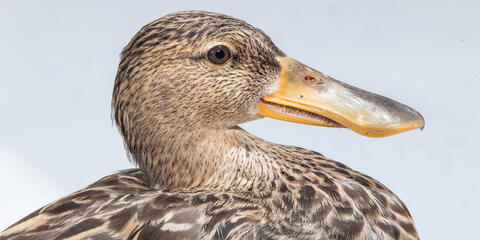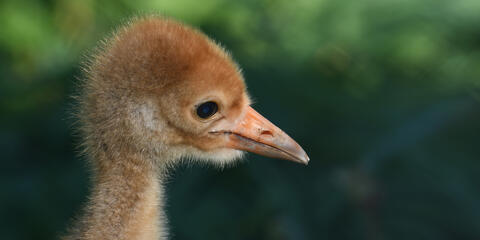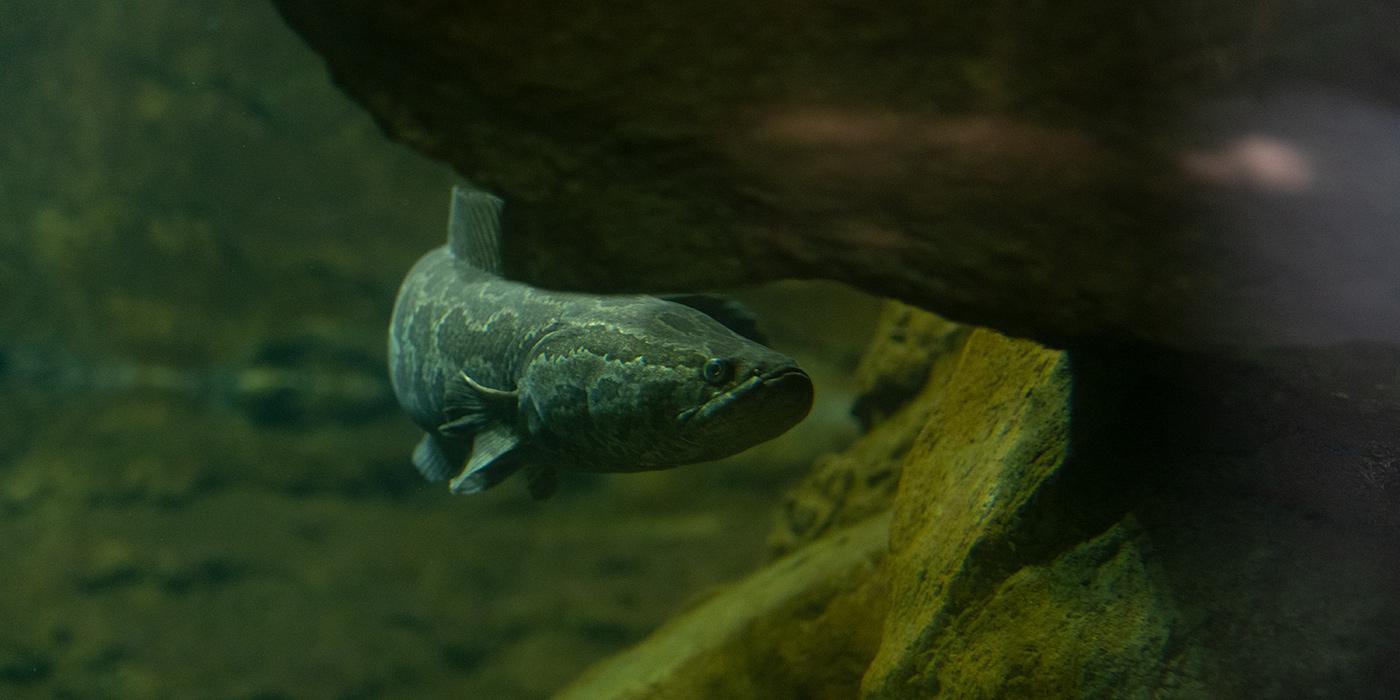Physical Description
Northern snakehead fish are typically brown with dark, irregular blotches. They have long, thin dorsal fins (the fins located on their backs) and sharp teeth. Although they look similar to bowfin, a species native to North America, northern snakeheads have a longer anal fin (the fin located on their underside, near the tail) and lack a bony plate between their lower jaws. Male and juvenile bowfins have a more rounded tail with a dark spot (called an “eyespot”) at its base.
A specialized chamber next to the snakehead's gills enables it to absorb oxygen by taking big gulps of air through its mouth. This adaptation makes it possible for northern snakehead fish to survive for up to four days on land, though this has only been observed in juveniles. Northern snakeheads can also enter torpor, a state of inactivity, which allows them to survive in very low temperatures and under the ice.
Size
Northern snakeheads can exceed 33 inches (84 centimeters) in length and can weigh up to 19 pounds (8.6 kilograms).
Native Habitat
Northern snakehead fish are native to China, Southern Siberia, and North Korea. They are an invasive species in North America. In 2002, they were discovered in the U.S. in Maryland and North Carolina. They had likely been imported to fish markets, then unlawfully released. They have since been found along the East Coast, in parts of California, and in the Mississippi River and Lake Michigan.
Snakehead fish prefer to live in shallow ponds, swamps and slow-moving streams that have a lot of plants and muddy surfaces. They can also be found in canals, reservoirs, lakes and rivers. While the optimal temperature range for northern snakeheads is 41-60 degrees Fahrenheit (5-16 degrees Celsius), they can tolerate temperatures as low as 32 F (0 C) and greater than 86 F (30 C). Their ability to adjust to various depths, temperatures and oxygen levels allows them to survive in many different types of aquatic environments.
Lifespan
Northern snakeheads have an average lifespan of 10 years but have been documented living as long as 15 years.
Food/Eating Habits
Northern snakeheads are aggressive, carnivorous fish with dagger-like teeth. Freshly hatched fry feed on zooplankton, and later, small insects and crustaceans. Juveniles eat small fish, while adults can eat fish that are up to 33% of their own body length, such as loach, bream and carp. Adults will also eat dragonfly larvae, beetles and frogs.
At the Zoo, northern snakehead fish eat goldfish, earthworms and crayfish.
Reproduction and Development
In their native habitats, northern snakeheads reach sexual maturity when they are 2-3 years old. In places where they have been introduced, they may reach sexual maturity after only one year. Spawning (when fish release their eggs) typically begins at the end of April and continues through August. A single snakehead may spawn up to five times each year, releasing up to 1,500 eggs each time. Their eggs can hatch within three days.
Snakeheads create large floating nests for their eggs. Once the eggs hatch, the young snakehead fish stay together in what is known as a "fry ball." Snakeheads are fiercely protective of their young. The parents remain nearby, ready to distract any predators by splitting up the floating circle of fry and luring predators away. Once the danger has passed, the young snakeheads rejoin the circle. The protection allows more young to survive, increasing the number of these fish — including in areas where they are invasive.
Conservation Efforts
Northern snakehead fish are native to Asia but an invasive species in North America. Invasive species are nonnative species that have been introduced to an area where they have a negative impact on local wildlife and ecosystems. Northern snakeheads are considered destructive predators because they prey on smaller fish and may spread parasites to native species. Without natural predators, these aggressive carnivores can also outcompete native species for food and habitat, making them a threat to the function of local ecosystems.
Snakeheads were likely introduced to North America through unauthorized, intentional releases from aquariums or live food markets. Their flexible diets, ability to survive in a wide range of habitats, large spawning sizes (up to 1,500 eggs), and the actions they take to protect their young have allowed them to thrive in the northern United States and southern Canada. To combat the spread of snakeheads in the U.S., the Lacey Act has made it illegal to ship snakeheads across state lines or own the invasive species in many states. However, it is not uncommon for northern snakeheads to be illegally sold in areas where their sale is prohibited.
Invasive species have increased as commerce and foreign travel have become more globalized. There are around 50,000 nonnative species in the U.S. alone, 4,300 of which are considered invasive. The introduction of nonnative species disrupts natural ecosystems, but there are actions people can take to prevent their spread.
Anyone who sees a snakehead fish in their local waterways should report the sighting to their state's natural resources department. Any snakehead fish that is caught should not be released back into the water. The Maryland Department of Natural Resources directs those harvesting northern snakeheads to kill them immediately after they are caught. They also ask Maryland recreational fishers to report northern snakeheads by emailing a photo of their catch to fishingreports.dnr@maryland.gov with details including the number of snakeheads caught, the length of each fish and the location of capture (as specific as possible).
Help this Species
- Choose your pets wisely, and do your research before bringing an animal home. Exotic animals don’t always make great pets. Many require special care and live for a long time. Tropical reptiles and small mammals are often traded internationally and may be victims of the illegal pet trade. Never release animals that have been kept as pets into the wild.
- Be a responsible consumer by ensuring that your food is legally sourced. It is illegal to buy live snakeheads in the continental United States and it is unlawful to import or possess dead snakeheads in several states.
- Share the story of this animal with others. Simply increasing awareness and educating others about the threats invasive species pose to local ecosystems can help protect native environments.
Animal News

Historic Hatching: Northern Shoveler Ducklings



